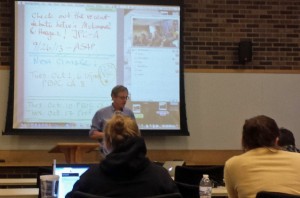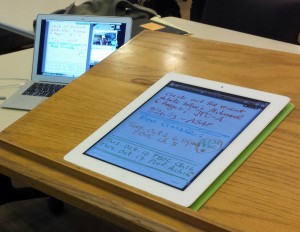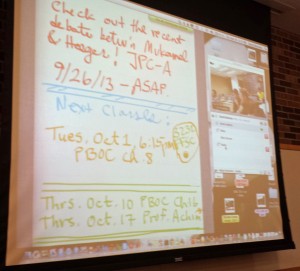Dr. David Beratan teaches graduate-level Chemistry 590 Special Topics in Chemistry: Models for Complex Materials to 9 Duke students, plus about a dozen students at Carnegie Mellon University and the University of Pittsburgh. In addition, drawn by Dr. Bera tan’s expertise, collaborations, and acquaintances, students and faculty are participating in the course in person at Duke, and virtually from Pittsburgh, Tulane University in New Orleans, Illinois Institute of Technology in Chicago, UNC Chapel Hill, and the National Science Foundation inWashington DC. The course also has an auditor who will start as a grad student next year at Duke and a University of Chicago undergrad. How? With the help of Bill Day (Computer Systems Manager in Chemistry), and patience, persistence, and good humor.
tan’s expertise, collaborations, and acquaintances, students and faculty are participating in the course in person at Duke, and virtually from Pittsburgh, Tulane University in New Orleans, Illinois Institute of Technology in Chicago, UNC Chapel Hill, and the National Science Foundation inWashington DC. The course also has an auditor who will start as a grad student next year at Duke and a University of Chicago undergrad. How? With the help of Bill Day (Computer Systems Manager in Chemistry), and patience, persistence, and good humor.
Technology
 Dr. Beratan uses WebEx to connect to the remote locations. The Duke students meet in a classroom in the French Family Science Center; the WebEx session is run from Dr. Beratan’s MacBook Air, which is connected via a wired connection to Duke’s internet in the classroom. The WebEx session is projected onto the classroom screen for Duke students who see the faces of the remote students when they speak; all students see what he writes on his iPad either projected in the classroom or on their own laptops via WebEx. Local and remote students connect to the WebEx sessions; students in Pittsburgh gather in one computer classroom with one main WebEx link; others connect via individual computers. When I observed the class, between eight and nine sites were simultaneously participating in the class via WebEx.
Dr. Beratan uses WebEx to connect to the remote locations. The Duke students meet in a classroom in the French Family Science Center; the WebEx session is run from Dr. Beratan’s MacBook Air, which is connected via a wired connection to Duke’s internet in the classroom. The WebEx session is projected onto the classroom screen for Duke students who see the faces of the remote students when they speak; all students see what he writes on his iPad either projected in the classroom or on their own laptops via WebEx. Local and remote students connect to the WebEx sessions; students in Pittsburgh gather in one computer classroom with one main WebEx link; others connect via individual computers. When I observed the class, between eight and nine sites were simultaneously participating in the class via WebEx.
 Dr. Beratan sketches on his iPad using the Noteshelf app to accompany his explanations. The laptop uses the Reflector app and a private wireless network to mirror the iPad surface onto the laptop so that his sketches and writing can be shared via WebEx. This requires an iPad version 2 or higher and exploits the iPad’s AirPlay capability; the local network is easily established using “Create network” on the Mac (hint: be sure neither the laptop or iPad is allowed to sleep, as that will disrupt the connection).
Dr. Beratan sketches on his iPad using the Noteshelf app to accompany his explanations. The laptop uses the Reflector app and a private wireless network to mirror the iPad surface onto the laptop so that his sketches and writing can be shared via WebEx. This requires an iPad version 2 or higher and exploits the iPad’s AirPlay capability; the local network is easily established using “Create network” on the Mac (hint: be sure neither the laptop or iPad is allowed to sleep, as that will disrupt the connection).
All participants are enroll ed in Dr. Beratan’s Sakai course as students or auditors, which provides access to the course syllabus, announcements, readings and notes from the class, homework, and a dropbox for submitting assignments via Sakai. The Pittsburgh and CMU students have signed up for a sister course at their institutions; they are doing all of the work assigned by Dr. Beratan but are being graded by their local faculty.
ed in Dr. Beratan’s Sakai course as students or auditors, which provides access to the course syllabus, announcements, readings and notes from the class, homework, and a dropbox for submitting assignments via Sakai. The Pittsburgh and CMU students have signed up for a sister course at their institutions; they are doing all of the work assigned by Dr. Beratan but are being graded by their local faculty.
Course Activities
I attended a class session in which student groups gave presentations to describe how they plan to model the solar cell structures for an assignment due in about a week, using fundamental knowledge gained in the prior 4 weeks of the course. Groups from both Duke and University of Pittsburgh/CMU took turns presenting, using a laptop computer with a webcam. Some groups used PDF documents to accompany their verbal explanations, other groups use Mathematica, and another group included hand-drawn sketches held up to a webcam to communicate their ideas. Students easily adapted their presentations to use the technology; it looked similar to using Skype to talk with friends. Lectures up to today have conveyed information by discussion, iPad writing, and extensive use/demonstration/exploration of model calculations using Mathematica.
Despite some technology issues, which were resolved quickly and creatively, students remained engaged during the almost three hour class, and even asked questions of each other’s presentations between sites. Students continued discussing the topic even after the class was over.
Dr. Beratan also uses WebEx for office hours for all course participants.
Logistics
The class meets weekly on Thursday evenings for 2.5 hours, with a short break in the middle. The course’s once-a-week, evening meeting made it easier to conform to academic calendars at different institutions, and to the teaching requirements of first year grad students. In addition, the long meeting time allows for time to fix potential technical issues while only affecting a small portion of the class time, so glitches aren’t overwhelming.
Students at University of Pittsburgh are enrolled in a similar special topics course at their university; their homework and other materials are graded by their faculty members, who attend in person or via WebEx (one is a rotator at NSF and sometimes, herself, connects by WebEx from DC). Students at Carnegie Mellon are enrolled in the University of Pittsburgh course, and will receive credit through an interinstitutional agreement.
Dr. Beratan hopes that this model will allow other graduate level courses on special, cutting edge topics to be taught more often at Duke and at other collaborating graduate institutions. The instructors would rotate among the participating universities, while enrolling students at all of the universities. Therefore, an individual faculty member would only teach the course every third (or so) offering, but the course would be offered to graduate students at each university more frequently, perhaps every year.
Dr. Beratan says:
This course has been a blast. I wanted to accomplish several aims with this experiment:
1) I wanted to teach a modern course that emphasizes molecular FUNCTION. So much of the chemistry curriculum is about static structure and lacks the dynamics that we care deeply about. I knew Duke enrollment would be modest (the 8 or 9 students here is more than first expected) and thought the course would gain in value if more students were impacted, so I began to think about how to accomplish this with technology.
2) I wanted to explore how to convey the fundamental core physical principles that underpin and are essential to understanding “impossibly complex” real systems like solar cells and biological motors.
3) I wanted to figure out how to enrich the first year grad offerings given limited faculty resources at Duke and at the Universities of my scientific collaborators, using technology to help magnify the impact of my efforts.
4) I wanted to strengthen our funded collaborations at Pitt, CMU, and Tulane (NSF, DOE support) and other projects that are in the emerging stages. This includes getting our students to know one another and discuss topics of mutual interest. Ideally, in future years, student working groups would span institutions. This activity also supports the “broader impact” aims of our NSF grants as well as the DOE basic energy sciences goal of bolstering student education and training.
5) I wanted to play with the technology to see how well remote participants could be included in a real course of modest size, not a MOOC. This opens the door further to remote guest expert lectures and discussion in the future.
Surprises:
1) The students are really good sports, have stayed engaged, and seem to enjoy being part of a two-fold experiment – one on course design and content, and another on course delivery and collaboration.
2) The technology works pretty well, even using voice over internet rather than phone dial in (which we are not really equipped to do in the classrooms – and cell phone quality is no better than voice over internet).
3) Despite wall mounted cameras and speaker in the classrooms, they don’t “talk” to WebEx.
4) It’s important to pause the class a few times each evening for “local” discussions and/or problem solving.
5) Discussion among the sites is really facilitated by having multiple faculty involved. So even though the Pittsburgh faculty are only giving a couple of formal lectures (probably 2), they stimulate remote discussion quite substantially and provide resources outside of class as well. As such, this activity requires more than 1.0 faculty effort, but much less than full commitment of all faculty. This role could be eased to some extent with TA involvement.
6) Some of the essential Mathematica activities were made possible by leveraging earlier developments in grad and undergrad phys chem courses that I taught.
7) My fear was that watching a screen or monitor for 2.5 hrs at a remote site would be tedious. My colleagues tell me that this is not a problem, and is eased by local team activities and breaks. I will be better able to judge this myself after the guest lectures from the Pittsburgh participants. The student working group presentations are engaging. I can improve the local audio quality and sound volume by bringing external speakers to plug into my laptop.
Other courses have been taught as partnerships with distant universities using different technologies. For example, in 2008, the course “Constructing Immersive Virtual Worlds” in the Information Science and Information Studies program included Duke students and students at East China University of Science and Technology in Shanghai via both web and video conferencing.
Currently, Duke is partnered with the University of Virginia to increase the number of less-commonly taught languages available at both universities through video conferencing. Tibetan and Creole are being taught across the campuses this semester. They use Cisco TelePresence technology, a high-quality video conferencing system which facilitates communication between students at the two universities by making them feel like they are in the same room.
For another example of using WebEx to teach at Duke, attend a talk by Mine Çetinkaya-Rundel on October 9, 2013 at 4 pm in Perkins 217 about her summer online, flipped and synchronous course.

Wow, chemistry is such a wonderful subject to know about the molecular functions, reactions and learning from David Beratan will be a great boon.